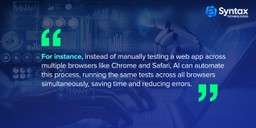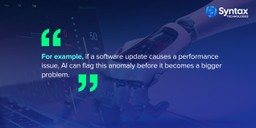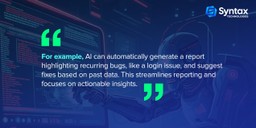Imagine spending weeks testing a new software, only to realize a critical bug slipped through because it was too complex or rare for manual testers to catch. Now, picture AI stepping in, automating repetitive tasks, and detecting issues you might miss—faster and more accurately. Sounds like a huge relief, right?
In today’s fast-paced tech world, AI helps in QA by transforming how we approach software testing. While AI is often surrounded by hype and fancy buzzwords, it’s important to understand where it truly delivers value. This blog will break down how AI helps in QA beyond the buzz, focusing on real-world results like improved test coverage, data generation, and faster bug detection. By the end, you’ll see how AI isn’t just a trend, but a powerful tool that’s reshaping QA processes for the better.
What is AI in QA?
At its core, AI in QA uses machines and algorithms to help test software automatically. Instead of human testers manually checking every part of a program, AI can step in and do much of the work, often faster and more accurately.
AI in QA typically involves tools that use Machine Learning, Data Analysis, and Pattern Recognition to simulate testing scenarios. For example, AI can predict where bugs might appear or even identify issues before they happen. This means quicker and more efficient testing, helping companies release high-quality software faster.
How is AI Better than Traditional QA?
Let’s talk about why AI helps in QA in a way that’s different from traditional methods:
- Speed: AI can run tests much faster than a human tester can. While a human might need hours or days to test everything, AI can complete similar tasks in minutes, saving tons of time.
- Accuracy: AI can reduce human errors. Testing software manually can sometimes mean missing certain bugs or glitches, especially when there are many variables. AI, on the other hand, can go through all the details without missing anything.
- Scalability: AI doesn’t get tired. It can run thousands of tests simultaneously, which is impossible for humans to keep up with. This makes it ideal for large-scale projects where you need to test on multiple platforms, devices, or environments.
- Cost Efficiency: While setting up AI tools might require an initial investment, in the long run, it helps save money by reducing the need for large teams of manual testers and catching bugs earlier in the development cycle.
In short, AI helps in QA by making the process faster, more accurate, and cost-effective, all while handling tasks that would otherwise be time-consuming and repetitive for human testers.
Key Areas Where AI Delivers Results in QA
Now, let’s dive into the areas where AI helps in QA and actually makes a real impact:
1. Test Coverage
Test coverage refers to how much of the application is tested during the QA process. With traditional QA, testers often focus on the most common use cases, sometimes missing edge cases or specific conditions.
AI can help improve test coverage by:
- Automatically identifying areas of the code that need testing.
- Suggesting new test cases based on the application’s code, ensuring that even obscure parts of the software are thoroughly tested.
2. Data Generation
Data generation is a huge part of QA testing. For testing to be effective, you need realistic test data—something that’s not always easy to generate manually. AI steps in here by generating realistic, varied data that covers a wide range of scenarios.
- AI helps in QA by automatically generating large datasets, including edge cases and rare situations that might not occur often but could still break the system.
3. Test Execution and Automation
One of the biggest advantages of AI is its ability to automate repetitive tasks. Traditional QA often involves repetitive manual tasks like running the same test on different browsers or devices. This is where AI helps in QA by automating these repetitive tests.
- AI tools can learn from past tests and adjust future testing strategies accordingly.
- They can identify which tests are most likely to fail based on historical data and prioritize them, making the whole testing process more efficient.
4. Bug Detection
Bug detection is a critical part of QA. Detecting issues early in the development process saves a lot of time and money down the line. AI has a huge advantage here, as it can quickly identify bugs that may be overlooked by human testers.
- AI helps in QA by analyzing patterns in code and identifying potential bugs based on known error patterns.
- AI tools can even detect bugs by recognizing anomalies in the way the software behaves, such as performance drops or crashes that humans may miss.
5. Reporting
Once testing is complete, the results need to be analyzed and reported. Traditionally, this means someone manually going through test results and creating reports. With AI, this process is automated.
- AI helps in QA by analyzing large sets of test results and generating insightful reports that highlight issues and trends in the data.
- AI can even offer recommendations for how to fix specific bugs or improve the software based on the test results.
The Real Impact of AI in QA
- Increased Efficiency: AI-driven tools can complete tasks in a fraction of the time it would take human testers, leading to faster product releases.
- Improved Quality: By catching bugs early and ensuring comprehensive testing, AI helps improve the quality of software.
- Cost Savings: While AI tools might have an upfront cost, they save money by reducing the need for manual labor and preventing costly issues from slipping through the cracks.
Conclusion
In conclusion, AI helps in QA by automating repetitive tasks, improving test coverage, detecting bugs faster, and generating insightful reports. It’s not just about the hype—AI is making a tangible difference in the quality and speed of software testing.
For those looking to break into the field of QA and Software Development Engineering in Test (SDET), learning how to leverage AI can be a turning point. Syntax Technologies offers an SDET course that equips you with the skills to master both manual and automated testing, including AI-driven testing tools.
By incorporating AI in your QA processes, you can ensure faster, more reliable software releases with fewer bugs. Whether you’re starting your career in QA or looking to enhance your skills, embracing AI is the future of testing.






